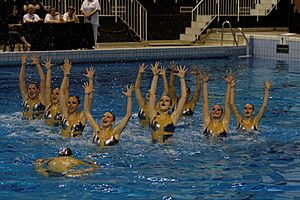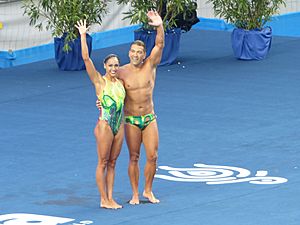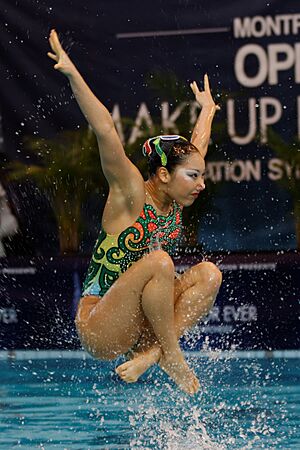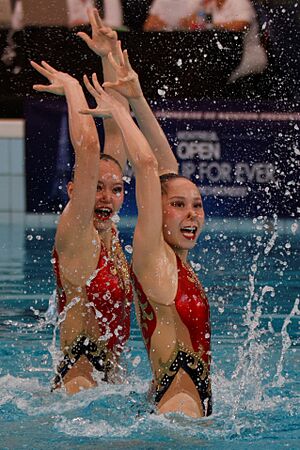Synchronized swimming facts for kids

Czech synchronized swimming team performing a free routine combination in 2013
|
|
| Highest governing body | World Aquatics (formerly known as FINA) |
|---|---|
| Characteristics | |
| Contact | No |
| Type |
|
| Venue | Swimming pool |
| Presence | |
| Olympic | Yes |
Synchronized swimming (in British English, synchronised swimming) or artistic swimming is a sport where swimmers perform a synchronized choreographed routine, accompanied by music. The sport is governed internationally by World Aquatics (formerly known as FINA). It has traditionally been a women's sport, although FINA introduced a new mixed gender duet competition that included one male swimmer in each duet at the 2015 World Aquatics Championships and LEN introduced men's individual events at the 2022 European Aquatics Championships. From 2024, men will be able to compete in the team event at the Olympics.
Synchronised swimming has been part of the Summer Olympics program since 1984 and now features women's duet and team events. On instruction of the International Olympic Committee (IOC), FINA renamed the sport from "synchronized swimming" to "artistic swimming" in 2017. The new official name has yet to gain general acceptance outside the core of the sport.
Contents
Basic skills
Sculls
Sculls (hand movements used to propel the body) are some of the most essential part to synchronised swimming. Commonly used sculls include support scull, stationary scull, propeller scull, alligator scull, torpedo scull, split scull, barrel scull, spinning scull, totem scull, canoe scull and paddle scull. The support scull is used most often to support the body while a swimmer is performing upside down.
The support scull or "American Scull" was invented by Marion Kane Elston and propelled the sport to new heights. The sport was transformed from water ballet to the athleticism of modern-day synchronized swimming. See the International Swimming Hall of Fame as a reference.
Support scull is performed by holding the upper arms against the sides of the body and the fore arms at 90-degree angles to the body, with hands facing the bottom of the pool. The fore arms are then moved back and forth while maintaining the right angle. The resulting pressure against the hands allows the swimmer to hold their legs above water while upside down.
Eggbeater
The "eggbeater kick" is another important skill of synchronised swimming. It is a form of treading water that allows for stability and height above the water while leaving the hands free to perform arm motions. An average eggbeater height is usually around collarbone level. Eggbeater is used in all "arm" sections, a piece of choreography in which the swimmer is upright, often with one or both arms in the air. Another variation is a body boost, which is executed through an eggbeater buildup and a strong whip kick, propelling the swimmer out of the water vertically. A body boost can raise a swimmer out of the water to hip level.
Lifts and highlights
A lift or highlight is when members of the team propel another teammate relatively high out of the water. They are quite common in routines of older age groups and higher skill levels. There are many variations on lifts and these can include partner lifts, float patterns or other areas of unique, artistic choreography intended to exceptionally impress the judges and audience.
Parts
There are three parts to every lift in synchronised swimming: The top (or "flyer"), the base, and the pushers. Sometimes there is no base and the pushers push the flyer directly.
- The Flyer is usually the smallest member of the team. Flyers must be agile and flexible, with a preferable gymnastics background if they are jumping off the lift.
- The Base tends to be of average size. Intense leg strength and a solid core is mandatory as well as the ability to hold a squat position.
- The Feet/Lifters/Pushers are the team members that provide the force for the base to explosively stand up, and the flyer to gain height out of the water.
Common types
- The platform lift is the oldest form of highlight. In a platform, the base lays out in a back layout position underwater. The top sets in a squatting position on her torso and stands once the lift reaches the surface. The remaining teammates use eggbeater to hold the platform and the top out of the water.
- The stack lift is the most common form of lifts in synchro. The base sets up in a squatting position a few feet underwater, with the lifters holding her feet and/or legs. The top then squats on the shoulders of the base. As the lift rises, lifters extend their arms while the base and top extend their legs to achieve maximum height. A common addition to a stack lift is a rotation while it ascends or descends.
- A toss or throw is set up exactly like a stack lift. However, when the lift reaches its full height, the "flyer" on top of the lift will jump off of their teammate's shoulders, usually performing some sort of acrobatic movement or position. This is a very difficult lift and should only be attempted by experienced swimmers.
- A basket or bunken toss is a newer form of highlight that utilizes a small platform created by the interlocking hands of two lifters persons, with the flyer standing on their hands, and the base inverted standing on the underside of their hands. There will be one person lifting each of the lifters’ waists, and another person deep under the basket assisting the base in remaining vertical. These highlights are often used by national teams to achieve exceptional height out of the water for the flyer.
Positions
There are hundreds of different regular positions that can be used to create seemingly infinite combinations. These are a few basic and commonly used ones:
- Back Layout: The most basic position. The body floats, completely straight and rigid, face-up on the surface while sculling under the hips.
- Back Tuck Somersault: Start in a back layout position. Bring your legs into your chest and pivot yourself backwards doing a full rotation or 360. From the tuck position, extend your legs and finish in a back layout position.
- Ballet Leg: Beginning in a back layout, one leg is extended and held perpendicular to the body, while the other is held parallel to the surface of the water.
- Bent Knee (or Heron): While holding a vertical body position, one leg remains vertical while the other leg bends so that its toe is touching the knee of the vertical leg.
- Crane (or Fishtail): While holding a vertical body position, one leg remains vertical while the other is dropped parallel to the surface, making a 90-degree angle or "L" shape. More specifically, a crane position requires the 90-degree angle in the legs (even if the bottom leg is submerged), while a fishtail requires the bottom foot to be at the surface which may or may not create a 90-degree angle in the legs depending on height.
- Double Ballet Leg: Similar to ballet leg position where both legs are extended and held perpendicular to the body.
- Flamingo: Similar to ballet leg position where bottom leg is pulled into the chest so that the shin of the bottom leg is touching the knee of the vertical leg, while remaining parallel to the surface of the water.
- Front Layout: Much like a Back Layout, the only difference is that the swimmer is on his/her stomach, sculling by his/her chest, and not breathing.
- Front Walkover: Begin in a front layout position. Scull downwards into a pike position. Lift one leg vertically into a crane position. Lower that same leg into a split position. Lift the remaining leg vertically into a knight position. Lower the remaining leg and scull above your head into a back layout position.
- Knight: The body is in a surface arch position, where the legs are flat on the surface, and the body is arched so that the head is vertically in line with the hips. One leg is lifted, creating a vertical line perpendicular to the surface.
- Side Fishtail: Side fishtail is a position which one leg remains vertical, while the other is extended out to the side parallel to the water, creating a side "Y" position.
- Split Position: With the body vertical, one leg is stretched forward along the surface and the other extended back along the surface, in an upside down split position.
- Tower: Start in a front layout position. Scull downwards into a pike position. Lift one leg vertically into a crane position. Lift the other leg into a vertical position and descend into the water.
- Tub: Both legs are pulled up to the chest with the shins and tops of the feet dry and parallel on the surface of the water.
- Vertical: Achieved by holding the body completely straight upside down and perpendicular to the surface usually with both legs entirely out of water.
The International Olympic Committee has further described the technical positions.
Routine
Routines are composed of "figures" (leg movements), arm sections and highlights. Swimmers are synchronised both to each other and to the music. During a routine swimmers can never use the bottom of the pool for support, but rather depend on sculling motions with the arms, and eggbeater kick to keep afloat. After the performance, the swimmers are judged and scored on their performance based on execution, artistic impression, and difficulty. Execution of technical skill, difficulty, patterns, choreography, and synchronization are all critical to achieving a high score.
Technical vs. free routines
Depending on the competition level, swimmers will perform a "technical" routine with predetermined elements that must be performed in a specific order. The technical routine acts as a replacement for the figure event. In addition to the technical routine, the swimmers will perform a longer "free" routine, which has no requirements and is a chance for the swimmers to get creative and innovative with their choreography.
Length
The type of routine and competition level determines the length of routines. Routines typically last two to four minutes, the shortest being the technical solo, with length added as the number of swimmers is increased (duets, teams, combos and highlight). Age and skill level are other important factors in determining the required routine length.
Scoring
Previously, free routines are scored on a scale of 100, with points for execution, artistic impression, and difficulty. As of 2021, however, the scoring system was changed so that difficulty & execution was worth more than artistic impression. Therefore, free routines now have no upper limit when it comes to final scores. Technical routines have also the evaluation of technical elements. In group routines a group consists of 8 competitors for World Championships and FINA events, each missing participant brings penalty points to the team. A group can consist of a minimum of 4 competitors and a maximum of 10 (for Free Combination and Highlight). If a swimmer touches the bottom, they will be given a penalty; however, if they use the bottom (by pushing off of it), they will be disqualified.
Preparation
When performing routines in competition and practice, competitors wear a rubber noseclip to keep water from entering their nose when submerged. Some swimmers wear earplugs to keep the water out of their ears. Hair is worn in a bun and flavorless gelatin, Knox, is applied to keep hair in place; a decorative headpiece is secured (bobby-pinned or sewed) to the bun. Recently, a new substance has been developed to replace Knox, called Synkro Gelatin. Rarely, swimmers wear custom-made swimming caps in place of their hair in buns.
Competitors wear custom swimsuits, usually elaborately decorated with bright fabric and sequins to reflect the music to which they are swimming. The costume and music are not judged but create an aesthetic appeal to the audience.
Makeup is also worn in this sport, but FINA has required a more natural look. No "theatrical make-up" is allowed, only makeup that provides a natural, clean and healthy glow is acceptable. In Canada, eye makeup must be smaller than a circle made by the swimmer's thumb and forefinger, and be used solely for "natural enhancement".
Underwater speakers ensure that swimmers can hear the music and aid their ability to synchronize with each other. Routines are prepared and set to counts in the music to further ensure synchronization. Coaches use underwater speakers to communicate with the swimmers during practice. Goggles, though worn during practice, are not permitted during routine competition unless the swimmers have medical disabilities or conditions.
Competitions
Figures
A standard meet begins with the swimmers doing "figures", which are progressions between positions performed individually without music. All swimmers must compete wearing the standard black swimsuit and white swim cap, as well as goggles and a noseclip. Figures are performed in front of a panel of 5 judges who score individual swimmers from 1 to 10 (10 being the best). If the swimmer does not do the correct figure, it may result in them getting a zero. The figure competition prefaces the routine events. However, figures are only performed when a swimmer is under the age of 15/16 and has not reached the junior age group.
United States
In the United States, competitors are divided into groups by age. The eight age groups are: 12 and under, 13–15, 16–17, 18–19, Junior (elite 15–18), Senior (elite 15+), Collegiate, and Master. In addition to these groups, younger swimmers may be divided by ability into 3 levels: Novice, Intermediate, and age group. Certain competitions require the athlete(s) to pass a certain Grade Level. Grades as of now range from Level one to Level six, and will soon go to Level ten. Seasons range in length, and some swimmers participate year-round in competitions. There are many levels of competition, including but not limited to: State, Regional, Zone, National, Junior Olympic, and US Junior and Senior Opens. Each swimmer may compete in the following routine events: solo, duet, combo (consisting of ten swimmers), and team (consisting of eight swimmers). In the 12 & under and 13-15 age groups, figure scores are combined with routines to determine the final rankings. The 16-17 and 18-19 age groups combine the scores of the technical and free routines to determine the final rankings. USA Synchro's annual intercollegiate championships have been dominated by The Ohio State University, Stanford University, Lindenwood University (which no longer has a collegiate program), and The University of the Incarnate Word.
Canada
In Canada, as of 2010, synchronized swimming has an age-based structure system with age groups 10 & under, 12 & under, and 13–15 for the provincial levels. There is also a skill level which is 13–15 and juniors (16–18) known as national stream, as well as competition at the Masters and University levels. The 13–15 age group and 16–18 age group are national stream athletes that align with international age groups – 15 and Under and Junior (16–18) and Senior (18+) level athletes. Wildrose age group is for competitors before they reach 13–15 national stream. Wildrose ranges from Tier 8 and under 16 and over provincial/wildrose. These are also competitive levels. Recreational levels, called "stars", also exist. Synchro Canada requires that a competitor must pass Star 3 before entering Tier 1. To get into a Tier a swimmer must take a test for that Tier. In these tests, the swimmer must be able to perform the required movements for the level. (Canada no longer uses Tiers as a form of level placement). The Canadian University synchronised swimming League (CUASL) is intended for Canadian Swimmers who wish to continue their participation in the sport during their university studies, as well as offering a "Novice" category for those new to the sport. Traditionally, the top teams hail from McGill University, the University of Ottawa, and the University of British Columbia.
Men's and mixed competition

Some international, national and regional competitions allow men to compete, and the Fédération internationale de natation (FINA) introduced a new mixed duet competition at the 2015 World Aquatics Championships.
In the late 19th century, synchronised swimming was a male-only event. However, in the 20th century it became a women's sport, with men banned from many competitions. In the U.S., men were allowed to participate with women until 1941, when synchronised swimming became part of the Amateur Athletic Union (AAU). The AAU required men and women to compete separately, which resulted in a decline of male participants. In the 1940s and 1950s, Bert Hubbard and Donn Squire were among the top US male competitors.
In 1978, the U.S. changed their rules to allow men to once again compete with women. Rules in other countries varied; in the UK, men were prohibited from competing until 2014, while in France, Benoît Beaufils was allowed to compete at national events in the 1990s. American Bill May was a top competitor in the late-1990s and early-2000s. He medalled in several international events, including the 1998 Goodwill Games. However, male competitors were barred from top competitions, including the World Aquatics Championships and the Olympics. However, at the 2015 World Aquatics Championships, FINA introduced a new mixed duet discipline. Both May and Beaufils returned from decade-long retirements to represent their countries. Among their competitors were Russian Aleksandr Maltsev and Italian Giorgio Minisini, both over 15 years younger than May and Beaufils. Pairs from ten countries competed in the inaugural events. The 2016 European Aquatics Championships was the first time men were allowed to compete at the European Championships. While men are allowed in more events, they were still barred from competing in the 2016 Summer Olympics. FINA did propose adding the mixed duet competition to the 2020 Summer Olympics.
In 2022, FINA allowed men to compete as soloists at the 2022 FINA Artistic Swimming World Series and the 2022 FINA World Junior Artistic Swimming Championships and LEN allowed men to compete as soloists both at the European Junior Championships and the 2022 European Aquatics Championships. The International Olympic Committee allowed for the participation of up to two men per team of eight in a mixed gender team event at the 2024 Olympic Games, competition of men in duet, solo, and men-only team events was not permitted. The mixed team format for the 2024 Olympic Games was adapted from the mixed team format, up to two men allowed per team, used at the 2022 FINA Artistic Swimming World Series (March to May 2022).
Men's solo events are scheduled to debut at the senior World Championships level at the 2023 World Aquatics Championships with solo technical and solo free routines.
See also
 In Spanish: Natación sincronizada para niños
In Spanish: Natación sincronizada para niños
- NHK Twinscam
- Swimming (sport)
- Water aerobics
- Water polo
- Composite stroke
- List of synchronised swimmers



